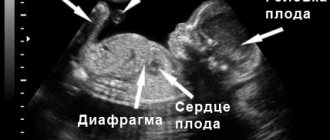Pregnancy Varvara Igoreva 05/14/2018
Mother’s feelings in the seventh obstetric month of pregnancy, fetal development, its height and weight. What kind of discharge occurs at 31 weeks of pregnancy and when to consult a doctor.
- 1 Fetus at 31 weeks of gestation
- 2 Fetal presentation
- 3 Allocations
- 4 Ultrasound examination and its standards
- 5 Oligohydramnios during pregnancy 31 weeks
- 6 Low placentation during pregnancy 31 weeks
- 7 Short cervix during pregnancy 31 weeks
- 8 Other pains and what to do about pain
- 9 31 weeks pregnant, no movements
- 10 How should a pregnant woman eat?
- 11 Nesting
- 12 Leakage of amniotic fluid
- 13 Intimacy
Fetus at 31 weeks of gestation
This is the 31st obstetric week of pregnancy and the 7th obstetric month. During this obstetric month, the baby grows and develops greatly. But for now it is still developing and this development does not imply interruption at any stage. Now it fills the muscle mass. At this time, his weight is about 1.5 kg or more, and his height is about 40 cm. This weight is enough for now, but he already weighs a lot. There have been cases when children were born and weighed the same. And yet the internal organs continue to form.
The pancreas learns to produce insulin, although its cells are still multiplying, and the liver can already partially cleanse the child’s blood of toxins. The lungs are still preparing, it’s time for them to produce surfactant. This is a substance that prevents the alveolar sacs from sticking together. They inflate with obstetric cotton.
The brain, its nerve endings, cells and neural connections are also in development. The fibers are surrounded by protective membranes, but the child feels the mother and even reacts to her mood changes. At this time, the baby can already recognize extrauterine sounds, the eyes can see a little, and the sense of smell is still developing. He even has nails with which he can accidentally touch his eyes while he constantly touches everything around him, the uterus and water, and feels himself. But at the same time it will only close your eyes. This is how he begins to understand the world. What brings a joyful feeling to pregnant women. Although this is a period of low activity, it becomes more difficult for him to move due to the space he takes up. But he moves as much as he can, even turns over.
Fetus at 31 weeks of gestation
Popular articles now
Cancer patient Boris Korchevnikov is afraid of loneliness: his mother is looking for the ideal daughter-in-law
Oleg Vinnik's wife took the stage: the singer could not hold back his touching feelings
Pregnant Ani Lorak took the stage: for the first time she was able to talk about children publicly
TOP 10 children's programs and animated series
show more
Yes, you found out the baby’s sex at 23 weeks, but sexual characteristics are still developing. The testicles still don’t want to descend, and the girls’ labia are still open. The baby's skin is a little transparent and the baby will still have to grow the epidermis. His diet so far consists only of incoming elements through the mother's blood and ingestion of amniotic fluid.
Norm of fetal motor activity
The fetus is in constant motion, except during periods of sleep. Thus, it was calculated that at 20 weeks a child makes up to 200 movements during the day, at 26-32 weeks the number of movements increases to 600, then motor activity begins to decrease, which is associated with an increase in the size of the fetus. Naturally, the woman does not feel most of these movements.
A child’s motor activity depends on many factors
:
- Time of day
(as a rule, the fetus is more active in the evening and at night); - Psychological state of a woman
. In stressful situations, the mother’s state of fear, the child may hide or, on the contrary, begin to move very actively; - Physical exercise
. The most frequent and strongest movements of the fetus become when the mother is at rest; - Women's nutrition
. When the mother feels hungry, the child begins to move more actively, and movements also become stronger and more distinct after eating food, especially sweets; - Ambient sounds
. The child reacts to loud, sharp sounds with increased movements; in some cases, on the contrary, he may calm down; - Uncomfortable prolonged position of the mother
(as a rule, the fetus reacts to it with increased and painful movements).
information On average, while the child is awake, a woman can feel up to 10-15 pushes per hour. Normally, movements may be completely absent for 3-4 hours, during which time the child sleeps.
Fetal presentation
By this obstetric week, the baby should already have found its position; it takes several months to form. But sometimes it happens that it changes. And the baby is in a completely different presentation than just a couple of weeks ago. When considering children, there are two main abdominal presentations: breech and cephalic. In rare cases, the child lies across his stomach. It does not depend in any way on the weight of the child. During this week, the most correct position is considered to be the head to the pelvis. This will make it easier for him to be born. In cases of breech presentation, the baby appears to be sitting. With a breech presentation, the risk of complications after childbirth is higher. Breech presentation is also considered a reason for cesarean section, especially when the placenta is in a low position and the opening in the hip joints is small, so as not to injure the mother. There is no need to be horrified by this, it’s all just for your sake.
If you give birth to twins, it will be a little more difficult for you. It is always difficult to give birth to twins since this is already a multiple pregnancy. But imagine how interesting it will be if you have twins. But with twins it is not easy, even if they are both lying correctly, this does not mean that one of them will not roll over when the first one comes out. And there are no guarantees for a successful birth without a cesarean section.
Optimal weight at 28 weeks of pregnancy
For all pregnant women, the pressing question is what weight should be at 28 weeks of pregnancy. This is a really important question, since extra pounds can do more harm than good during childbirth. Therefore, at every gynecological examination, a woman weighs herself and measures her blood pressure.
Why can a lot of weight be a problem? When a pregnant woman weighs herself, there is no distinction as to who has how many kilograms. A child can take on excess weight. In this case, the fetus will be large and there is a very high probability that the mother will be injured during childbirth, and the child may receive damage in the birth canal. If the mother takes on the extra pounds, this can result in a malfunction of the kidneys, endocrine system, metabolism and cardiovascular system. There is also a high probability of varicose veins. The most optimal weight gain for this period is 6-8 kg, since you still have 2.5 months to walk.
Ultrasound examination and its standards
It’s 31 weeks of pregnancy and it’s time to do one of the most important stages of the study, ultrasound screening. This is just the time for the third screening, where you can once again see the development of the child or twins. A screening study is always important, because it also identifies possible risks. During the ultrasound of the 31st week of pregnancy, the doctor will conduct the necessary studies, evaluate the child’s indicators, and will also interpret the ultrasound at the 31st week of pregnancy. During the study you will learn:
- Child parameters, height, weight and others;
- To what extent does its development correspond to the term;
- What is the baby's heartbeat like in the womb?
- Condition of the cervix and the uterus itself;
- What is the situation with amniotic fluid?
Ultrasound examination and its standards
If the umbilical cord is wrapped around the baby's body, you will most likely have a cesarean section to avoid suffocation of the fetus. According to multiple indicators, even before the 27th week, you could have been prescribed an abortion for positive purposes. But now you no longer have to worry about the risk of abortion and termination of pregnancy. At this stage, abortion is no longer legal in many countries.
Methods for counting fetal movements
Baby moving
– this is a kind of indicator of his well-being. Too violent, painful or, on the contrary, rare weak movements can be a bad prognostic sign and indicate the development of acute or chronic fetal hypoxia. Also, changes in movement may appear when the volume of amniotic fluid is disturbed: with oligohydramnios, movements become stronger and more painful; with polyhydramnios, on the contrary, the motor activity of the fetus becomes less noticeable.
At the moment, there are several methods for determining the motor activity of the fetus.
:
- Pearson method
; - Cardiff method
; - Sadowski method
.
Pearson method
The Pearson method involves observing the baby's movements for 12 hours (from 9 am to 9 pm).
At this time, a woman should limit physical activity as much as possible, because... it can reduce fetal motor activity.
The time of the beginning of counting and every tenth movement of the fetus should be entered in a special table, as well as any movements of the fetus should be recorded. If less than an hour passes between the first and tenth movements, this is a normal indicator of fetal movement. If more than an hour passes, the woman should try to independently provoke increased fetal movements (walk up the stairs, lie on her back, eat something sweet) and continue counting the movements. If rare movements continue throughout the day, you should definitely consult a doctor and undergo additional examination.
Cardiff method
The Cardiff method is also based on counting movements over 12 hours, but the woman can choose the start time of the study herself
. The table records the start time of counting and the time when the tenth movement occurred. If the tenth fetal movement occurred earlier than 12 hours later, then the counting can be completed. If a child does not make ten movements within 12 hours, a mandatory consultation with a doctor is necessary.
Sadowski method
Sadowski's method is based on counting movements after dinner in the period from 7 pm to 11 am
(in the evening and after eating, the child’s movements always intensify). The woman should record the start time of counting and lie down on her left side (this position also increases the motor activity of the fetus). If the child makes ten or more movements within an hour, then the counting can be stopped. If there were fewer movements, then the woman should continue to count the movements of the fetus further. A slowdown in fetal movements of less than ten within two hours is considered a bad prognostic sign; in this case, additional examination (CTG, ultrasound, Doppler) is prescribed.
dangerous A menacing and alarming indicator is a decrease in motor activity or the disappearance of the child’s movements. This suggests that the fetus is already suffering from hypoxia, that is, lack of oxygen. If you notice that your baby begins to move less often, or you do not feel his movements for more than 6 hours, you should immediately consult an obstetrician. If it is not possible to visit a doctor on an outpatient basis, you can call an ambulance.
First of all, the doctor will use an obstetric stethoscope to listen to the fetal heartbeat; normally it should be 120-160 beats per minute (on average 136-140 beats per minute). Even if during normal auscultation (listening) the fetal heart rate is determined within normal limits, it is necessary to perform another procedure - a cardiotocographic study (CTG). CTG is a method that allows you to evaluate the fetal heartbeat and its functional state, to check whether the baby is suffering from hypoxia (lack of oxygen).
During the study, a special sensor is attached with straps to the anterior abdominal wall on the back of the child in the approximate projection of his heart. This sensor detects the fetal heartbeat curve. At the same time, the pregnant woman holds a special button in her hand, which should be pressed when she feels the fetus moving.
This is shown on the chart with special marks. Normally, in response to movement, the fetal heart rate begins to increase in frequency: this is called the “motor-cardiac reflex.” This reflex appears after 30-32 weeks, so CTG before this period is not sufficiently informative.
CTG is performed for 30 minutes. If during this time no increase in heart rate is recorded in response to movements, then the doctor asks the pregnant woman to walk for a while or climb up the stairs several times, and then makes another recording.
If myocardial complexes do not appear, then this indirectly indicates fetal hypoxia (lack of oxygen). In this case, and also if the baby begins to move poorly before 30-32 weeks, the doctor will prescribe a Doppler test. During this test, the doctor measures the speed of blood flow in the umbilical cord vessels and in some fetal vessels. Based on these data, it is also possible to determine whether the fetus is suffering from hypoxia.
Low placentation during pregnancy 31 weeks
You may have been diagnosed with low placentation using ultrasound. There are not many women with this placentation, but not a few. The placenta is located lower, and this can happen to the placenta due to many factors, even indirectly related to pregnancy. For example, this most often happens in women during breech and oblique births. It’s already quite a long time, but the placenta can still change in location, and the presentation, accordingly, will become not pelvic, but cephalic. If this has not yet happened, you will be under constant medical supervision. Since due to such placentation, hypoxia may develop, or placental abruption may occur.
Short cervix during pregnancy 31 weeks
The approximate parameter this week should be about 35 mm. A short neck can be with a lower parameter, but it attracts the most attention if it is 25 mm long. All this can be seen during screening. The baby still needs to grow, and the cervix is already short and loses elasticity, which reduces the ability to carry the baby to term. If you have a short cervix, doctors will prescribe you special medications to slightly reduce the excitability of the uterus, and this helps with the diagnosis itself. What to do if your stomach hurts at 31 weeks of pregnancy
Pregnant bellies are often painful during this time. You may be experiencing regular false Braxton-Higgs contractions. Maybe the child is simply putting pressure on your organs due to your low position. Twins are especially often characterized by such sensations. But if you take the right position, then you can cope with twins. If your stomach becomes stone, just below the navel, then most likely the tone has begun and it’s time to call an ambulance, you are in labor. A sign of tone is a painful and stony belly. With tone at 31 weeks, timely provision of medical care is very important.
What tests need to be taken
In order for the doctor to understand what is happening to the expectant mother and whether there is a threat of complications, an examination is prescribed. Minimum - for all women, extended - for those at risk. At 21 weeks from conception there are no mandatory tests, and if a doctor’s visit is planned at this time, only a urine test will be needed.
Already at this time, when visiting a antenatal clinic, a CTG recording can be performed - recording the fetal heartbeat. However, according to the clinical protocols of the Ministry of Health, many institutions practice this procedure only from the 28th obstetric week.
How should a pregnant woman eat?
Eat often, but little by little, and watch your weight, because childbirth is coming soon. Nutrition must also correspond to the regime. You need vitamins and it’s better to take a whole set at once. With this set, you will not need to take several tablets a day, but only one. Food should be light, but healthy. Food should be varied with various protein products: milk, meat, cheeses, in short, everything that has enough protein and calcium. The weight of the fetus depends on the amount of microelements and vitamins.
How should a pregnant woman eat?
At this time, heartburn and bloating are possible. Pregnant women especially suffer from heartburn during the 31st week of pregnancy. You can get rid of heartburn by simply eliminating everything unhealthy from food: salty, fried and smoked foods. Dairy products also slightly suppress heartburn.
See also Nothing superfluous: how to control weight during pregnancy?
Intimacy
This week, partners often move away a little. Women simply have no desire due to hormones, and men are afraid that they may harm the child or mother. You should be careful during sex, but doctors have not yet prohibited it. Of course, if there are no contraindications. Rough sex will have to be postponed and deep penetrations too. Choose from the pregnancy poses that suit you best. Sexuality and pregnancy are compatible concepts!
Location of the fetus in the uterus
At this stage, the baby can position himself as he pleases without consequences, since for another 2-4 weeks he can roll over and kick at his mother. If it is located upside down or across, there is no reason for frustration yet. You need to consult your doctor about whether you need to do additional exercises to turn the fetus over. More often they are prescribed at a later stage for an easier delivery. When the head is down, this is the ideal presentation. Live for the child, get positive emotions, and the birth will go well!









